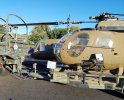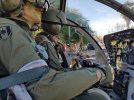-
Please take a moment and update your account profile. If you have an updated account profile with basic information on why you are on Air Warriors it will help other people respond to your posts. How do you update your profile you ask?
Go here:
Edit Account Details and Profile
You are using an out of date browser. It may not display this or other websites correctly.
You should upgrade or use an alternative browser.
You should upgrade or use an alternative browser.
Random Griz Aviation Musings
- Thread starter Griz882
- Start date
Like the AF, CAP is all about the record keeping - a combination of FAA airworthiness + AF and CAP stuff - everything from cockpit placarding to a review of airframe, engine and prop log books for things like annuals, ELT inspections, 50 hour oil changes, 100 hour inspections, biannual corrosion proofing, etc. 80% paperwork and 20% poking your head in the actual aircraft (AROW, survival kit, etc).These are CAP aircraft in local "squadrons"? What does on inspection entail?
Very different than Navy processes. Everything in the aircraft down to what seat pocket a manual or checklist is in - is prescribed. But these are $400k+ assets that the good taxpayers have funded. There's 12 aircraft in Michigan alone. (3 year old G1000 C182 as an example - over $500K new). At first I though the standardization was a bit overboard but the plus side is any pilot across the country who is qualified in type can walk up to an aircraft anywhere in the country and be assured of its airworthiness and maint status quickly, and go fly.
A lot of my job I am discovering is oversight and governance for the budget that AF gives CAP. NDAA has a single line item for CAP administered by AF. Fairly generous.t There is a good deal of work to ensure the money is being spent in accordance with law and AF regs. I also think, there is some intent to keep the GA industry base going and Cessna and Textron seem to be doing alright as are the network of maintenance providers. There are some interesting mission studies going on right now and that includes options for procuring a more diverse fleet - given that the AF operates both Cirrus (AF Academy) and Diamond (AF flight screening), those types are already in the system procurement wise and I think are front runners. Shadowing a Predator in Special Use Airspace assumes you can keep up with it speed wise. Hard to do in a 135 Kt airplane. Likewise training Cadets for their Private Pilot rating in a Cessna 206 six seat StationAir at 15-20GHP of avgas is a bit too much.
I flew up with a colleague - even though I flew, I am still not officially qualified (even though I have hundreds of PIC hours in the C182 and C206. Before the AF will allow me to start training I need to graduate AF flight physiology training and do a chamber ride. I don't quite get the chamber ride requirement, but its a thing even though I am not flying pressurized aircraft, nor anything that goes above 14.5K.
Last edited:
Good news this week. A local guy has had a super nice OH-6A on a trailer display for years. Mannequins for crew, mucho weapons, the detail is awesome. Like the sort of thing you see inside museums. On veterans day he told the SW Chapter of Army Aviation Heritage Foundation that he would give us operational control for upkeep and scheduling purposes, as he is not giving it the attention it deserves. Just a couple days ago he went all the way and donated his Loach to us.
In Vietnam for over two years, 70,71,72. The owner flew this aircraft in the Army. Crashed due to enemy fire 5 times. Spent time with NASA. Was one of a handful of the OH-6s that made up the short lived Silver Bells, the Army flight demo team. When with the NY Guard was stolen and crashed in NJ. That is a real M134 minigun. If you look closely you see the rounds in the belt are corroded. That is the sort of thing we will be taking care of.
Known as "Charlie Chopper" this thing is all about the details. Check out the wrist watch. Besides the M134 on the left, the copilot is rocking a M60 on a bungee. To the right of the pilot in a rack is a M16. There are smoke grenades, frag grenades, copilot's M16 in the back. The crew sports survival radios, knives and 1911s. In the chin bubble is two flak jackets. I'll get better pics of the detail later.
No, we are not going to fly her. She was in airworthy condition when acquired many years ago. It has just sat too long and been through too much, operationally. We already have an OH-6 under restoration to airworthy status. For the airworthy project we will liberate certain flyable parts from Charlie Chopper and replace them with timed out, not documented or otherwise non flyable parts where we can.
So now the fleet comprises one airworthy UH-1H slick about to come out of restoration. One flying AH-1F down for major maintenance. A UH-1M gunship for trailered static display (in the back ground of the above picture), a historic museum quality UH-1B gunship on loan to the local CAF museum, a second AH-1F ready for paint that will be a trailered static display, an airworthy OH-6A under restoration, and Charlie Chopper. I am still jonesing for a O-1/L-19 Bird Dog I can fly. A Bird Dog would fill out the entire task element in Vietnam.

In Vietnam for over two years, 70,71,72. The owner flew this aircraft in the Army. Crashed due to enemy fire 5 times. Spent time with NASA. Was one of a handful of the OH-6s that made up the short lived Silver Bells, the Army flight demo team. When with the NY Guard was stolen and crashed in NJ. That is a real M134 minigun. If you look closely you see the rounds in the belt are corroded. That is the sort of thing we will be taking care of.

Known as "Charlie Chopper" this thing is all about the details. Check out the wrist watch. Besides the M134 on the left, the copilot is rocking a M60 on a bungee. To the right of the pilot in a rack is a M16. There are smoke grenades, frag grenades, copilot's M16 in the back. The crew sports survival radios, knives and 1911s. In the chin bubble is two flak jackets. I'll get better pics of the detail later.
No, we are not going to fly her. She was in airworthy condition when acquired many years ago. It has just sat too long and been through too much, operationally. We already have an OH-6 under restoration to airworthy status. For the airworthy project we will liberate certain flyable parts from Charlie Chopper and replace them with timed out, not documented or otherwise non flyable parts where we can.
So now the fleet comprises one airworthy UH-1H slick about to come out of restoration. One flying AH-1F down for major maintenance. A UH-1M gunship for trailered static display (in the back ground of the above picture), a historic museum quality UH-1B gunship on loan to the local CAF museum, a second AH-1F ready for paint that will be a trailered static display, an airworthy OH-6A under restoration, and Charlie Chopper. I am still jonesing for a O-1/L-19 Bird Dog I can fly. A Bird Dog would fill out the entire task element in Vietnam.
Very nice. FYI, the guy with the M-60 is an “Aeroscout Observer,” a no longer used MOS. ? This link is to a great report on how the Army developed a training matrix for the job.Good news this week. A local guy has had a super nice OH-6A on a trailer display for years. Mannequins for crew, mucho weapons, the detail is awesome. Like the sort of thing you see inside museums. On veterans day he told the SW Chapter of Army Aviation Heritage Foundation that he would give us operational control for upkeep and scheduling purposes, as he is not giving it the attention it deserves. Just a couple days ago he went all the way and donated his Loach to us.View attachment 28187
In Vietnam for over two years, 70,71,72. The owner flew this aircraft in the Army. Crashed due to enemy fire 5 times. Spent time with NASA. Was one of a handful of the OH-6s that made up the short lived Silver Bells, the Army flight demo team. When with the NY Guard was stolen and crashed in NJ. That is a real M134 minigun. If you look closely you see the rounds in the belt are corroded. That is the sort of thing we will be taking care of.View attachment 28188
Known as "Charlie Chopper" this thing is all about the details. Check out the wrist watch. Besides the M134 on the left, the copilot is rocking a M60 on a bungee. To the right of the pilot in a rack is a M16. There are smoke grenades, frag grenades, copilot's M16 in the back. The crew sports survival radios, knives and 1911s. In the chin bubble is two flak jackets. I'll get better pics of the detail later.
No, we are not going to fly her. She was in airworthy condition when acquired many years ago. It has just sat too long and been through too much, operationally. We already have an OH-6 under restoration to airworthy status. For the airworthy project we will liberate certain flyable parts from Charlie Chopper and replace them with timed out, not documented or otherwise non flyable parts where we can.
So now the fleet comprises one airworthy UH-1H slick about to come out of restoration. One flying AH-1F down for major maintenance. A UH-1M gunship for trailered static display (in the back ground of the above picture), a historic museum quality UH-1B gunship on loan to the local CAF museum, a second AH-1F ready for paint that will be a trailered static display, an airworthy OH-6A under restoration, and Charlie Chopper. I am still jonesing for a O-1/L-19 Bird Dog I can fly. A Bird Dog would fill out the entire task element in Vietnam.
Like the AF, CAP is all about the record keeping - a combination of FAA airworthiness + AF and CAP stuff - everything from cockpit placarding to a review of airframe, engine and prop log books for things like annuals, ELT inspections, 50 hour oil changes, 100 hour inspections, biannual corrosion proofing, etc. 80% paperwork and 20% poking your head in the actual aircraft (AROW, survival kit, etc).
Very different than Navy processes. Everything in the aircraft down to what seat pocket a manual or checklist is in - is prescribed. But these are $400k+ assets that the good taxpayers have funded. There's 12 aircraft in Michigan alone. (3 year old G1000 C182 as an example - over $500K new). At first I though the standardization was a bit overboard but the plus side is any pilot across the country who is qualified in type can walk up to an aircraft anywhere in the country and be assured of its airworthiness and maint status quickly, and go fly.
A lot of my job I am discovering is oversight and governance for the budget that AF gives CAP. NDAA has a single line item for CAP administered by AF. Fairly generous.t There is a good deal of work to ensure the money is being spent in accordance with law and AF regs. I also think, there is some intent to keep the GA industry base going and Cessna and Textron seem to be doing alright as are the network of maintenance providers. There are some interesting mission studies going on right now and that includes options for procuring a more diverse fleet - given that the AF operates both Cirrus (AF Academy) and Diamond (AF flight screening), those types are already in the system procurement wise and I think are front runners. Shadowing a Predator in Special Use Airspace assumes you can keep up with it speed wise. Hard to do in a 135 Kt airplane. Likewise training Cadets for their Private Pilot rating in a Cessna 206 six seat StationAir at 15-20GHP of avgas is a bit too much.
I flew up with a colleague - even though I flew, I am still not officially qualified (even though I have hundreds of PIC hours in the C182 and C206. Before the AF will allow me to start training I need to graduate AF flight physiology training and do a chamber ride. I don't quite get the chamber ride requirement, but its a thing even though I am not flying pressurized aircraft, nor anything that goes above 14.5K.
Are you one of the Full Time Reservist CAP members or still a volunteer? I'm assuming you're working at the wing or region level.
Serious question ChuckMK23. How do the kids in uniforms 4 sizes too big fit into all of this?
Those are the future leaders of the Air Force and America.
Can you say "cockpit FOD" ?So where does the spent brass go? All over the Pilot and the cockpit?
Those are the future leaders of the Air Force and America.
All the future leaders of the USN and USMC are currently in community service and work release programs, hopefully.
I met Juan a few years ago, and ran in to him at a U-2 party a few weeks ago. I had no clue he had this YouTube channel until I saw your post.An AA 777 FO with a pretty decent YouTube channel breaks it down (I believe he's a former AF C-141 dude)
I'm a Department of The Air Force GS employee...Are you one of the Full Time Reservist CAP members or still a volunteer? I'm assuming you're working at the wing or region level.
Those are the future leaders of the Air Force and America.
Army Kiowa dudes were routinely employing their M-4's from their cockpit seats - rifles were simply stored on top of glare shield.So where does the spent brass go? All over the Pilot and the cockpit?
I'm a Department of The Air Force GS employee...
Cool. I've never seen that particular side of the corporation and USAF interaction. I always figured there was somebody at Maxwell managing the planes but didn't know there were actual GS employees doing it.
Back when you were CAP he was probably one of the creepy old guys that you knew you shouldn't go flying with.Cool. I've never seen that particular side of the corporation and USAF interaction. I always figured there was somebody at Maxwell managing the planes but didn't know there were actual GS employees doing it.

